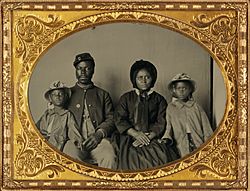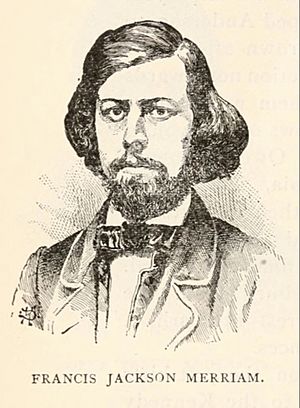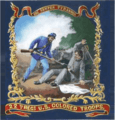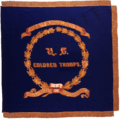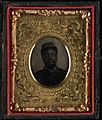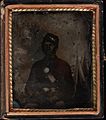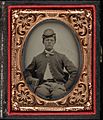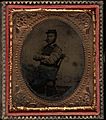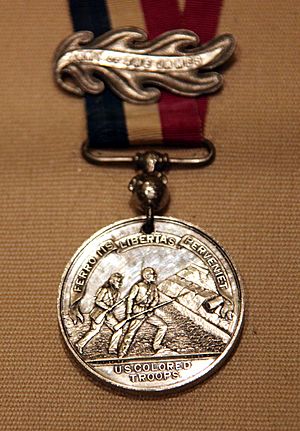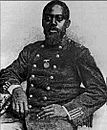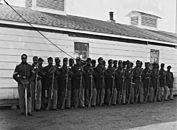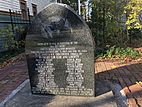United States Colored Troops facts for kids
Quick facts for kids USCT |
|
|---|---|
| United States Colored Troops | |
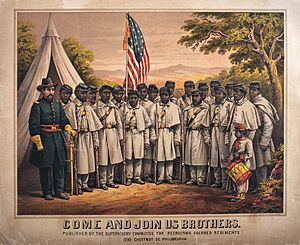
USCT recruiting poster
|
|
| Active | May 22, 1863 – Oct 1865 |
| Allegiance | Union |
| Branch | Army |
| Type | infantry, cavalry, artillery, engineering |
| Size | 175 regiments; 178,000 men |
| Motto(s) | Sic semper tyrannis |
| Engagements | American Civil War |
| Disbanded | October 1865 |
The United States Colored Troops (USCT) were special army groups during the American Civil War. These groups were mostly made up of African-American soldiers. Some members from other minority groups also served. They started joining the army in 1863. By the end of the war in 1865, about 175 USCT groups existed. They made up about one-tenth of the whole Union Army. Many USCT soldiers fought very bravely. Sixteen of them even received the Medal of Honor. This is the highest award for bravery in the United States.
The USCT groups were like early versions of the Buffalo Soldier groups. These groups later served in the American Old West.
Contents
History of the USCT
How the USCT Was Formed
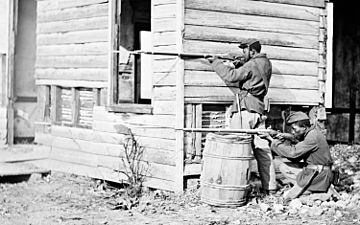
The U.S. Congress passed a law in July 1862. It was called the Confiscation Act of 1862. This law said that enslaved people whose owners were fighting against the United States were now free. Another law, the Militia Act of 1862, allowed the President to use free Black people and former enslaved people in the army.
President Abraham Lincoln was careful about this at first. He worried about what people in the four border states would think. These states were part of the Union but still had slavery. In September 1862, Lincoln announced the Emancipation Proclamation. This statement said that all enslaved people in states fighting against the Union would be free starting January 1, 1863. After this, the army began to recruit Black soldiers in large numbers.
On May 22, 1863, the War Department created the Bureau of Colored Troops. This bureau helped recruit African-American soldiers for the Union Army. Soldiers were recruited from all states in the Union. They joined different types of units, like infantry (foot soldiers), cavalry (soldiers on horseback), engineers, and artillery (soldiers who use cannons).
Serving in the War
About 178,000 free Black people and freedmen (formerly enslaved people) joined the USCT. They served during the last two years of the war. Their help was very important for the Union. By the end of the war, USCT soldiers made up almost one-tenth of all Union troops.
The USCT had 2,751 soldiers wounded or killed in battles. But a much larger number, 68,178, died from all causes. Like all troops, both Black and white, most deaths were caused by disease. In the last year and a half of the war, about 20% of all African Americans in the military died. This was a higher death rate than for white soldiers.
White Union officers led the USCT groups. Black soldiers could become non-commissioned officers (like sergeants). About 110 Black men became officers by the end of the war. Most of them were surgeons or chaplains. At first, Black soldiers were paid less than white soldiers. But they and their supporters worked hard to change this. Eventually, they received equal pay. Famous people like Martin Robinson Delany and the sons of Frederick Douglass were part of the USCT.
USCT engineers built Fort Pocahontas in Charles City, Virginia. This was a supply base for the Union. The bravery of Black troops during the Civil War helped African Americans gain new rights. Frederick Douglass wrote about this. He said that once a Black man wore the uniform, no one could deny his right to be a citizen.
Early Volunteer Groups
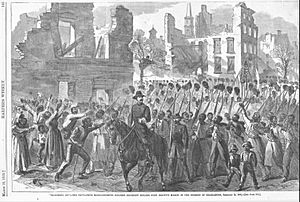
Before the USCT was officially formed, some volunteer groups were created. These groups were made of free Black men. Some were also freedmen from the South. In 1863, a former enslaved person named William Henry Singleton helped recruit 1,000 former enslaved people in New Bern, North Carolina. They joined the First North Carolina Colored Volunteers. Singleton became a sergeant in the 35th USCT. Most of these early volunteer groups later became part of the USCT.
Singleton wrote a book about his life, from slavery to becoming a Union soldier. He even marched in a parade at 95 years old in 1938.
State Volunteer Groups
Some groups were considered "Regular" army units, not just helpers. This meant their soldiers could get good government jobs after the war. These jobs were usually not open to African Americans before. However, these soldiers did not get official recognition for their bravery until the early 1900s.
These special units included:
- 5th Regiment Massachusetts Colored Volunteer Cavalry
- 54th Massachusetts (Colored) Volunteer Infantry Regiment
- 55th Massachusetts (Colored) Volunteer Infantry Regiment
- 29th Connecticut (Colored) Volunteer Infantry Regiment
- 30th Connecticut Volunteer Infantry Regiment
- 31st Infantry Regiment (Colored)
Louisiana Native Guard
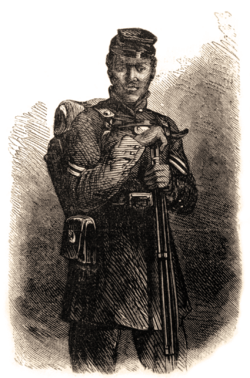
The 1st Louisiana Native Guard was formed in New Orleans. This happened after Union forces took control of the city. This group included "free people of color" who owned property. It also included freedmen from refugee camps. These freedmen had no way to earn money or a place to live. The Union Army needed more soldiers. So, they gave these volunteers old uniforms and weapons. The soldiers were paid less than white soldiers. They mostly did guard duties. In return, their families received food, clothes, and housing at army camps. Schools were often set up for them.
These soldiers fought bravely. They served in battles like the Battle of Port Hudson. Their units included:
- 4 Regiments of Louisiana Native Guards (later renamed as US Colored Infantry).
- Cavalry, Infantry, and Engineer Regiments (also later renamed as US Colored units).
- 1 Regiment of Heavy Artillery (later 10th US Colored (Heavy) Artillery).
The engineers built Bailey's Dam. This helped save the Union navy's ships.
Other USCT Units
Colored troops also worked as laborers in the 16th Army Corps. They helped with supplies and building.
The USCT had many different types of regiments:
- 6 Regiments of Cavalry
- 1 Regiment of Light Artillery
- 13 Heavy Artillery Regiments
- 135 Regiments of Infantry (some were never fully formed)
Gallery
-
Harriet Tubman with family and ex-slaves; sitting at left is Tubmans 2nd husband Nelson Davis (8th USCT veteran)
Important Battles and Actions
The first time African-American soldiers fought against Confederate forces was at the Skirmish at Island Mound in Missouri. This happened on October 28–29, 1862. African Americans, mostly escaped enslaved people, had joined the 1st Kansas Colored Volunteers. They went with white troops to stop Confederate guerrilla fighters. Even though they were outnumbered, the African-American soldiers fought bravely. The Union forces won the battle. News of this fight was shared in newspapers like The New York Times.
USCT groups fought in many parts of the war. But they often served as guard troops in safer areas. The most famous USCT action was at the Battle of the Crater during the Siege of Petersburg. USCT groups suffered many losses trying to break through Confederate lines. Other important battles include Fort Wagner, which was one of their first big tests, and the Battle of Nashville.
USCT soldiers were among the first Union forces to enter Richmond, Virginia, after it fell in April 1865. The 41st USCT group was there when the main Confederate army surrendered at Appomattox. After the war, USCT groups stayed in the former Confederate states as occupation troops.
General Ulysses S. Grant praised the USCT soldiers. He said they were good at following rules and fought bravely.
Prisoners of War
Some USCT soldiers were captured during the war.
Numbers of Colored Troops by State
The soldiers are listed by the state where they joined the army. Many soldiers from Northern states were actually formerly enslaved people from the South. Also, many soldiers from states like Delaware, Kentucky, and Missouri were formerly enslaved.
| North | Number | South | Number |
|---|---|---|---|
| Connecticut | 1,764 | Alabama | 4,969 |
| Colorado Territory | 95 | Arkansas | 5,526 |
| Delaware | 954 | Florida | 1,044 |
| District of Columbia | 3,269 | Georgia | 3,486 |
| Illinois | 1,811 | Louisiana | 24,502 |
| Indiana | 1,597 | Mississippi | 17,869 |
| Iowa | 440 | North Carolina | 5,035 |
| Kansas | 2,080 | South Carolina | 5,462 |
| Kentucky | 23,703 | Tennessee | 20,133 |
| Maine | 104 | Texas | 47 |
| Maryland | 8,718 | Virginia | 5,723 |
| Massachusetts | 3,966 | ||
| Michigan | 1,387 | Total from the South | 93,796 |
| Minnesota | 104 | ||
| Missouri | 8,344 | At large | 733 |
| New Hampshire | 125 | Not accounted for | 5,083 |
| New Jersey | 1,185 | ||
| New York | 4,125 | ||
| Ohio | 5,092 | ||
| Pennsylvania | 8,612 | ||
| Rhode Island | 1,837 | ||
| Vermont | 120 | ||
| West Virginia | 196 | ||
| Wisconsin | 155 | ||
| Total from the North | 79,283 | ||
| Total | 178,895 |
After the Civil War
The USCT groups were ended in the fall of 1865. In 1867, the Regular Army created new regiments. Two regiments of Black cavalry (the 9th and 10th Cavalry) and four regiments of Black infantry were formed. Most of these soldiers were USCT veterans. Later, in 1869, the number of Black infantry regiments was reduced to two (the 24th and 25th Infantry).
From 1870 to 1898, Black soldiers made up 10% of the U.S. Army. USCT soldiers fought in the Indian Wars in the American West. There, Native Americans called them the Buffalo Soldiers. They said their hair looked like the curly fur of a bison.
Awards and Honors
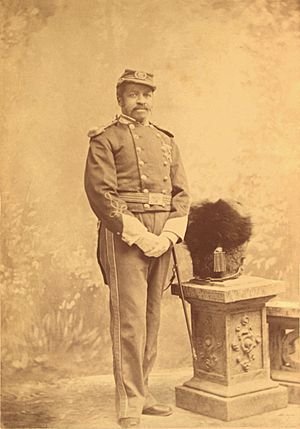
Soldiers who fought in the Army of the James could get the Butler Medal. This medal was created by General Benjamin Butler. In 1861, Butler was the first to say that enslaved people who escaped to Union lines were "contraband" (like captured enemy property). He refused to return them to their owners. This became a policy for the whole Union Army.
Sixteen African-American USCT soldiers earned the Medal of Honor. This is the highest award for bravery in the nation.
- Sergeant William Harvey Carney of the 54th Massachusetts (Colored) Volunteer Infantry received the Medal of Honor. This was for his actions at the Battle of Fort Wagner in July 1863. He was wounded but still carried the flag back to Union lines. He did not let go of it until he gave it to another soldier. Carney received his medal 37 years after the battle.
- Fourteen African-American soldiers, including Sergeant Major Christian Fleetwood, received the Medal of Honor. This was for their actions at the Battle of Chaffin's Farm in September 1864.
- Corporal Andrew Jackson Smith of the 55th Massachusetts (Colored) Volunteer Infantry was also recommended for the Medal of Honor. At the Battle of Honey Hill in November 1864, he saved the regimental flag from falling into enemy hands. He finally received his medal in 2001.
Legacy and Remembrance
Historians say that when enslaved people organized and worked with the Union Army, including in the USCT, it was a huge act of rebellion. It was bigger than any other slave revolt.
The African American Civil War Memorial Museum helps keep information about this time alive.
Tributes and Memorials
- In September 1996, a national event celebrated the service of the United States Colored Troops.
- The African American Civil War Memorial was built in Washington, D.C., in 1997. It has a sculpture called Spirit of Freedom.
- In 1999, the African American Civil War Museum opened nearby.
- In July 2011, the museum moved to a new building in Washington, D.C.
Remembering Their Story
Historians like W. E. B. Du Bois helped keep the story of the USCT alive. Since the 1970s, more books and movies have been made about them. During the war, it was hard for these soldiers to get official recognition for their bravery. Sometimes, recommendations for awards were ignored. Also, soldiers had to pay postage to receive their medals. Many former USCT soldiers had to send their medals back because they did not have enough money. The last USCT soldier, Joseph Clovese, died in 1951.
The movie Glory tells the story of the 54th Massachusetts Volunteer Infantry Regiment. This group was not officially a USCT regiment, but a state volunteer group. The movie shows the training and battles of African-American troops. It helps people understand the challenges they faced during the Civil War. Many white officers who fought with Black soldiers changed their minds about them. They saw their Black comrades' bravery and courage.
|
See also
 In Spanish: Tropas de color de Estados Unidos para niños
In Spanish: Tropas de color de Estados Unidos para niños


